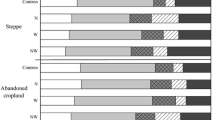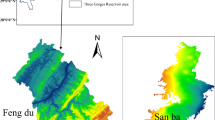Abstract
The extensive reclamation of marshland into cropland has tremendously impacted the ecological environment of the Sanjiang Plain in northeast China. To understand the impacts of marshland reclamation and restoration on soil properties, we investigated the labile organic carbon fractions and the soil enzyme activities in an undisturbed marshland, a cultivated marshland and three marshlands that had been restored for 3, 6 and 12 years. Soil samples collected from the different management systems at a depth of 0–20 cm in July 2009 were analyzed for soil organic carbon (SOC), dissolved organic carbon (DOC), microbial biomass carbon (MBC) and easily degradable organic carbon. In addition, the activities of the invertase, β-glucosidase, urease and acid phosphatase were determined. These enzymes are involved in C, N and P cycling, respectively. Long-term cultivation resulted in decreased SOC, DOC, MBC, microbial quotient and C (invertase, β-glucosidase) and N-transforming (urease) enzyme activities compared with undisturbed marshland. After marshland restoration, the MBC and DOC concentrations and the soil invertase, β-glucosidase and urease activities increased. Soil DOC and MBC concentrations are probably the main factors responsible for the different invertase, β-glucosidase and urease activities. In addition, marshland restoration caused a significant increase in the microbial quotient, which reflects enhanced efficiency of organic substrate use by microbial biomass. Our observations demonstrated that soil quality recovered following marshland restoration. DOC, MBC and invertase, β-glucosidase and urease activities were sensitive for discriminating soil ecosystems under the different types of land use. Thus, these parameters should be considered to be indicators for detecting changes in soil quality and environmental impacts in marshlands.


Similar content being viewed by others
References
Acosta-Martínez V, Cruz L, Sotomayor-Ramírez DD, Pérez-Alegría L (2007) Enzyme activities as affected by soil properties and land use in a tropical watershed. Applied Soil Ecology 35:35–45
Acosta-Martínez V, Acosta-Mercado D, Sotomayor-Ramírez D, Cruz-Rodríguez L (2008) Microbial communities and enzymatic activities under different management in semiarid soils. Applied Soil Ecology 38:249–260
Anderson TH, Domsch KH (1986) Carbon assimilation and microbial activity in soil. Journal of Plant Nutrition and Soil Science 149:457–468
Blair GJ, Lefroy RDB, Lise L (1995) Soil carbon fractions based on their degree of oxidation, and the development of a carbon management index for agricultural systems. Australian Journal of Agricultural Research 46:1459–1466
Bonnett SAF, Ostle N, Freeman C (2006) Seasonal variations in decomposition processes in a valley-bottom riparian peatland. Science of the Total Environment 370:561–573
Burket JZ, Dick RP (1998) Microbial and soil parameters in relation to N mineralization in soils of diverse genesis under differing management systems. Biology and Fertility Soils 27:430–438
Cang L, Zhou DM, Wang QY, Wu DY (2009) Effects of electrokinetic treatment of a heavy metal contaminated soil on soil enzyme activities. Journal of Hazardous Materials 172:1602–1607
Chan KY, Bowman A, Oates A (2001) Oxidizible organic carbon fractions and soil quality changes in an oxic paleustalf under different pasture leys. Soil Science 166:61–67
Contech A, Lefroy RDB, Blair GJ (1997) Dynamics of organic matter in soils as determined by variation in 13C/12C isotopic ratio and fractionation by ease of oxidation. Australian Journal of Agricultural Research 35:881–890
Cui BS, Yang QC, Yang ZF, Zhang KJ (2009) Evaluating the ecological performance of wetland restoration in the Yellow River Delta, China. Ecological Engineering 35:1090–1103
Davidson EA, Ackerman IL (1993) Changes of soil organic inventories following cultivation of previously untilled soils. Biogeochemistry 20:161–193
Eivazi F, Tabatabai MA (1988) Glucosidases and galactosidases in soils. Soil Biology and Biochemistry 20:601–606
Freeman C, Liska G, Ostle NJ, Jones SE, Lock MA, Hughes S, Reynolds B, Hudson J (1997) Enzymes and biogeochemical cycling in wetlands during a simulated drought. Biogeochemistry 39:177–187
Freeman C, Nevison GB, Hughes S, Reynolds B, Hudson J (1998) Enzymic involvement in the biogeochemical responses of a Welsh peatland to a rainfall enhancement manipulation. Biology and Fertility of Soils 27:173–178
Garcia C, Hernandez T, Roldan A, Martin A (2002) Effect of plant cover decline on chemical microbiological parameters under Mediterranean climate. Soil Biology and Biochemistry 34:635–642
Ghani A, Dexter M, Perrott KW (2003) Hot-water extractable carbon in soils: a sensitive measurement for determining impacts of fertilization, grazing and cultivation. Soil Biology and Biochemistry 35:1231–1243
Gong W, Hu TX, Wang JY, Gong YB, Ran H (2008) Soil carbon pool and fertility under natural evergreen broadleaved forest and its artificial regeneration forests in southern Sichuan Province, China. Acta Ecologica Sinica 28:2536–2545
Gregorich EG, Liang BC, Drury CF, Mackenzie AF, McGill WB (2000) Elucidation of the source and turn over of water soluble and microbial biomass carbon in agricultural soils. Soil Biology Biochemistry 32(5):581–587
Guan SY (1986) Soil enzymology and research method. Agricultural Press, Beijing, pp 274–323 (in Chinese)
Guo YD, Wan ZM, Liu DY (2010) Dynamics of dissolved organic carbon in the mires in the Sanjiang Plain, Northeast China. Journal of Environmental Sciences 22(1):84–90
Huang N, Liu DW, Wang ZM, Zhang B, Song KS, Li F, Ren CY (2009) Distribution features of natural wetland in the Sanjiang Plain from 1954 to 2005. Wetland Science 7:33–39
Jenkinson DS, Ladd JN (1981) Microbial biomass in soil: measurement and turnover. In: Paul EA, Ladd JN (eds) Soil biochemistry, vol 5. Marcel Dekker Inc., New York, pp 415–471
Jia GM, Zhang PD, Wang G, Cao J, Han JC, Huang YP (2010) Relationship between microbial community and soil properties during natural succession of abandoned agricultural land. Pedosphere 20(3):352–360
Jones TH, Thompson LJ, Lawton JH, Bezemer TM, Bardgett RD, Balckburn TM, Bruce KD, Cannon PF, Hall GS, Hartley SE, Howson G, Jones CG, Kampichler C, Kandeler E, Ritchie DA (1998) Impacts of rising atmospheric carbon dioxide on model terrestrial ecosystems. Science 280:441–443
Kang H, Freeman C, Ashendon TW (2001) Effects of elevated CO2 on fen peat biogeochemistry. The Science of the Total Environment 279:45–50
Kang H, Kim SY, Fenner N, Freeman C (2005) Shifts of soil enzyme activities in wetlands exposed to elevated CO2. Science of the Total Environment 337:207–212
Klose S, Tabatabai MA (2000) Urease activity of microbial biomass in soils as affected by cropping systems. Biology and Fertility of Soils 31:191–199
Loginow W, Wisniewski W, Gonet SS, Ciescinska B (1987) Fractionation of organic carbon based on susceptibility to oxidation. Polish Journal of Soil Science 20:47–52
Lu RK (2000) Soil agrochemistry analysis method. Chinese Agrotechnology Press, Beijing, pp 228–233 (in Chinese)
Marschner B, Kalbitz K (2003) Controls of bioavailability and biodegradability of dissolved organic matter in soils. Geoderma 113:211–235
Moorhead DL, Sinsabaugh RL (2000) Simulated patterns of litter decay predict patterns of extracellular enzyme activities. Applied Soil Ecology 14:71–79
Moscatelli MC, Tizio DA, Marinari S, Grego S (2007) Microbial indicators related to soil carbon in Mediterranean land use systems. Soil and Tillage Research 97:51–59
Paterson E, Hall JM, Rattray EAS, Griffiths BS, Ritz K, Killham K (1997) Effect of elevated CO2 on rhizosphere carbon flow and soil microbial processes. Global Change Biology 3:363–377
Powlson DS, Jenkinson DA (1981) A comparison of the organic matter, biomass, adenosine triphosphate and mineralizable nitrogen contents of ploughed and direct drilled soils. Journal of Agricultural Science 97:713–721
Raiesi F (2006) Carbon and N mineralization as affected by soil, cultivation and crop residue in a calcareous wetland ecosystem in Central Iran Agriculture. Ecosystems and Environment 112:13–20
Salazar S, Sánchez LE, Alvarez J, Valverde A, Galindo P, Igual JM, Peixa A, Santa-Regina I (2011) Correlation among soil enzyme activities under different forest system management practices. Ecological Engineering 37:1123–1131
Sicardi M, García-Préchac F, Frioni L (2004) Soil microbial indicators sensitive to land use conversion from pastures to commercial Eucalyptus grandis (Hill ex Maiden) plantations in Uruguay. Applied Soil Ecology 27:125–133
Sinsabaugh RL (1994) Enzymatic analysis of microbial pattern and process. Biology and Fertility of Soils 17:69–74
Sotomayor-Ramírez D, Espinoza Y, Acosta-Martínez V (2009) Land use effects on microbial biomass C, β-glucosidase and β-glucosaminidase activities, and availability, storage, and age of organic C in soil. Biology and Fertility of Soils 45:487–497
Steffen KT, Cajthaml T, Šnajdr J, Baldrian P (2007) Differential degradation of oak (Quercus petraea) leaf litter by litter-decomposing basidiomycetes. Research in Microbiology 158:447–455
Tripathi S, Chakraborty A, Chakrabarti K, Bandyopadhyay BK (2007) Enzyme activities and microbial biomass in coastal soils of India. Soil Biology and Biochemistry 39:2840–2848
Tscherko D, Bölter M, Beyer L, Chen J, Elster J, Kandeler E, Kuhn D, Blume HP (2003) Biomass and enzyme activity of two soil transects at King George Island, Maritime Antarctica. Arctic, Antarctic, and Alpine Research 35:34–47
Turner BL, Hopkins DW, Haygarth PM, Ostle N (2002) β-Glucosidase activity in pasture soils. Applied Soil Ecology 20:157–162
Wan ZM, Song CC, Guo YD, Wang L, Huang JY (2008) Effects of water gradients on soil enzyme activity and active organic carbon composition under Carexlasiocarpa marsh. Acta Ecologica Sinica 28:5980–5986
Wang CT, Long RJ, Wang QL, Liu W, Jing ZC, Zhang L (2010) Fertilization and litter effects on the functional group biomass, species diversity of plants, microbial biomass, and enzyme activity of two alpine meadow communities. Plant Soil 331:377–389
Wu J, Joergensen RG, Pommerening B, Chaussod R, Brookes PC (1990) Measurement of soil microbial biomass C by fumigation extraction—an automated procedure. Soil Biology and Biochemistry 22:1167–1169
Yang CM, Yang LZ, Ouyang Z (2005) Organic carbon and its fractions in paddy soil as affected by different nutrient and water regimes. Geoderma 124:133–142
Yang K, Zhu JJ, Zhang M, Yan QL, Sun JX (2010) Soil microbial biomass carbon and nitrogen in forest ecosystems of Northeast China: a comparison between natural secondary forest and larch plantation. Journal of Plant Ecology 3(3):175–182
Zhang JB (2006) Effects of wetland cultivation and land use on soil carbon fraction in the Sanjiang Plain. A Thesis Submitted to Graduate School, Chinese Academy of Sciences in Partial Fulfillment of the Requirement for the Degree of Doctor. Beijing, China (in Chinese)
Zhang GL (2010) Changes of soil labile organic carbon in different land uses in Sanjiang Plain, Heilongjiang province. Chinese Geographical Science 20(2):139–143
Zhang JB, Song CC, Yang WY (2007a) Effects of cultivation on soil microbiological properties in a freshwater marsh soil in Northeast China. Soil and Tillage Research 93:231–235
Zhang JB, Song CC, Wang SM (2007b) Dynamics of soil organic carbon and its fractions after abandonment of cultivated wetlands in northeast China. Soil and Tillage Research 96:350–360
Zhao LP, Jiang Y (1986) Measure method of soil phosphatase. Chinese Journal of Soil Science 17:138–141 (in Chinese)
Zornoza R, Guerrero C, Mataix-Solera J, Scow KM, Arcenegui V, Mataix-Beneyto J (2009) Changes in soil microbial community structure following the abandonment of agricultural terraces in mountainous areas of Eastern Spain. Applied Soil Ecology 42:315–323
Acknowledgments
We would like to thank the editors Rebecca Efroymson and Virginia Dale and the four anonymous reviewers for their helpful and constructive reviewing of this paper. In addition, we thank the individuals at the Sanjiang Experimental Station of Wetland Ecology for providing necessary experimental instrumentation. This work was funded by the Key Project of Chinese Academy of Sciences (KZCX2-YW-JC301), the National Natural Science Foundation of China (No. 41103038, 40930527), the National Basic Research Program (973) of China (No. 2009CB421103, 2010CB951304), and the “Strategic Priority Research Program-Climate Change: Carbon Budget and Related Issues” of the Chinese Academy of Sciences (XDA05050508).
Author information
Authors and Affiliations
Corresponding author
Rights and permissions
About this article
Cite this article
Song, Y., Song, C., Yang, G. et al. Changes in Labile Organic Carbon Fractions and Soil Enzyme Activities after Marshland Reclamation and Restoration in the Sanjiang Plain in Northeast China. Environmental Management 50, 418–426 (2012). https://doi.org/10.1007/s00267-012-9890-x
Received:
Accepted:
Published:
Issue Date:
DOI: https://doi.org/10.1007/s00267-012-9890-x




